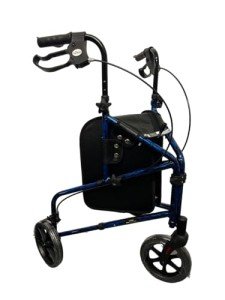This company has no active jobs
0 Review
Rate This Company ( No reviews yet )
About Company
This Is The Good And Bad About Ergonomic Rollator
Understanding Ergonomic Rollators: A Comprehensive Guide
As the population ages, the requirement for mobility aids becomes significantly vital. Among these aids, the rollator has actually gained popularity for its benefit and assistance. Nevertheless, not all rollators are developed equivalent. Get in the ergonomic rollator, a particularly created device targeted at boosting user comfort and mobility. This post explores the functions, benefits, and factors to consider of ergonomic rollators while offering insights into their growing value in senior health and wellness.
What is an Ergonomic Rollator?
An ergonomic rollator is a mobility aid developed to support individuals who might have problem walking or keeping balance. Unlike conventional walkers, rollators come equipped KMINA PRO Folding Walker with Seat – All Terrain wheels and brakes, permitting a smooth transition through different surfaces. The ergonomic style focuses on minimizing pressure on the user’s body, making it an ideal option for those Ultralight Tri-Walker with Seat – Mobility Made Easy arthritis, joint problems, or recovery from surgery.
Secret Features of Ergonomic Rollators
| Function | Description |
|---|---|
| Tri-Wheel Folding Walker: Adjustable Height Handlebars | These can be personalized to fit the user’s height, ensuring ideal posture and minimizing back pressure. |
| Lightweight Frame | Many ergonomic rollators are made from lightweight materials, enabling simple maneuverability. |
| Comfortable Seat | A cushioned seat offers an area for users to rest when required, promoting longer use without fatigue. |
| User friendly Brakes | The brakes are uncomplicated to run, improving safety throughout use. |
| Foldable Design | Perfect for transport and storage, ergonomic rollators can be easily folded when not in use. |
| Storage Options | Lots of models come equipped with baskets or pouches, providing added convenience for bring individual products. |
Benefits of Using an Ergonomic Rollator
The ergonomic rollator is developed with user functionality in mind. Here are a few of the primary benefits that make it a beneficial choice:
-
Enhanced Stability and Support: The structure of ergonomic rollators enables much better balance, empowering users to move 6-Wheel Sit & Go Shopping Trolley with Seat confidence.
-
Lowered Physical Strain: With adjustable features and support for much better posture, users can experience less tiredness and discomfort.
-
Increased Independence: By using an ergonomic rollator, numerous people gain back the capability to carry out everyday activities without depending on help.
-
Flexible Usage: Ergonomic rollators can be used both inside your home and outdoors, providing smooth mobility throughout different environments.
-
Promotes Active Living: Encouraging users to stay active is important for overall health; rollators offer the support required to check out safely.
FAQs About Ergonomic Rollators
What should I search for when buying an ergonomic rollator?
- Consider the weight capacity and measurements to ensure it is suitable for your requirements.
- Examine for functions like adjustable handlebars and brakes for individualized convenience.
- Try to find great evaluations and think about models with warranties for quality guarantee.
Are ergonomic rollators ideal for outdoor use?
- Yes, many ergonomic rollators are created with robust wheels and frames, making them perfect for different surfaces, consisting of sidewalks and parks.
How do I keep my ergonomic rollator?
- Routinely inspect the brakes, wheels, and frame for wear.
- Tidy the rollator with a moist fabric; prevent harsh chemicals that can damage its finish.
Can I use my ergonomic rollator for travel?
- Certainly! Many ergonomic rollators are created to be lightweight and foldable, making them easy to transportation and shop.
Will my insurance cover the expense of an ergonomic rollator?
- Protection may vary based upon your insurance coverage strategy. It is necessary to consult your provider for specific policies regarding mobility aids.
Factors to consider When Choosing an Ergonomic Rollator
When picking an ergonomic rollator, several key aspects need to be taken into consideration:

- Weight and Portability: Ensure the rollator is simple to raise and transport.
- Height Adjustability: Features must enable simple height modifications based upon user convenience.
- Wheel Size: Larger wheels are better for outdoor use, while smaller sized wheels are often adequate for indoor environments.
- Storage Capacity: Look for rollators with additional storage alternatives if bring products is required.
- Construct Quality: Select a rollator made from durable products that can withstand day-to-day wear and tear.
Tips for Safe Use of an Ergonomic Rollator
Using an ergonomic rollator securely is crucial for preventing accidents and making sure a smooth mobility experience. Here are some practical tips:
- Proper Setup: Adjust the handlebars to hip level before use for optimal posture.
- Check Brakes Before Use: Always guarantee the brakes are functioning properly before moving.
- Navigate Surfaces Carefully: Be cautious on uneven or slippery surfaces, as stability can differ.
- Use the Seat When Needed: If feeling fatigued, use the built-in seat for a rest before continuing your journey.
- Practice Turning: When turning, ensure to pivot instead of pulling the Rollator For Travel along, which can result in imbalance.
Ergonomic rollators represent a substantial development in mobility aids, catering particularly to the needs of those who need extra support while preserving independence. By comprehending the features, benefits, and appropriate use of ergonomic rollators, users can boost their mobility, enhance their lifestyle, and continue to engage with their environments with confidence. As the demand for efficient mobility solutions continues to grow, ergonomic rollators stick out as exemplary tools for promoting much better health and mobility in senior citizens and individuals with mobility obstacles.


